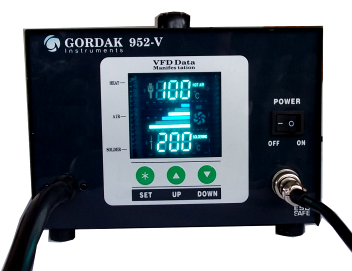Hello,
We have suffered several failures of the
Gordak 952-V solder station. The 952-V is one of the newer VFD models. It costs around US$150 delivered. So not the cheapest. [1]
The symptoms are dead screen and dead control buttons, cold blower and cold iron.

Gordak 952-V (when working!)
The seller says return the faulty stations for repair/replacement. But this is impractical. Return shipping to China costs as much as a new station.
Since the problem is common - it would be better to identify and fix it, and document the solution for others.
The
Gordak 952-V is driven by an
Atmel ATmega8L-8PU 8-bit microcontroller. The MCU is clocked externally at 8MHz. The MCU has an 8 bit AVR RISC core, 8kB of onboard flash, 512 byte EEPROM and 1kB of internal SRAM, and three digital IO ports. [2]
The VFD screen on the Gordak is driven by a
Princeton PT6312 VFD controller. The PT6312 can be seen on the reverse of the board below. [3]
The MCU drives the PT6312 via a 3 wire serial interface using its GPIO lines.
The Gordak's control board also has a couple of
OP07DP operational amplifiers, and a
TL431 adjustable voltage regulator. [4]
So it is not clear where the fault lies. The Gordak does have a separate power supply board. This was briefly tested and its outputs appear to be clean and in spec.
There are vendors on Taobao selling pre-programmed replacement MCUs for the Gordak 952-V. This suggests that their failure is common. Yet the ATmega8 is pretty resilient, so the underlying fault with the Gordaks is probably something else.
There are schematics for the earlier Gordak 952 [5] and for the Gordak 952A [6] but neither are very relevant to the MCU-based Gordak 952-V. The 952-V User Manual (Chinese and English) is here for anyone who has lost it. [7]
Any suggestions or pointers would be gratefully received

cheers,
asbokid
[1]
http://www.totobay.com/gordak-952v-intelligent-compositive-soldering-station220v_p29555.html[2]
http://www.atmel.com/images/doc2486.pdf[3]
http://www.princeton.com.tw/downloadprocess/downloadfile.asp?mydownload=PT6312.pdf[4]
http://www.ti.com/lit/ds/symlink/tl431.pdf[5]
http://archive.espec.ws/files/gordak.rar[6]
http://img339.imageshack.us/img339/2428/hotairschematicchamobil.pdf[7]
http://docs.google.com/folder/d/0B6wW18mYskvBQWlZN19B...